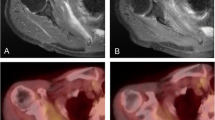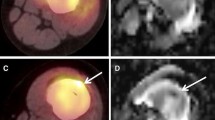Abstract.
Purpose: In the framework of the 3rd Consensus Conference „PET in Oncology“ the bone and soft-tissue tumors study group evaluated the present position of PET for these tumor entities on the basis of international publications. Methods: After a systematic review of the literature, publications were evaluated according to previously defined quality criteria. For various indications the clinical usefulness of PET was assessed using a classification system. Results: Most studies had been performed with a small number of patients (n < 35). Therefore, only 8 of 46 publications were judged relevant. On the basis of these literature data, use of FDG-PET for grading was classified 1 b (literature results predominantly show clinical usefulness). As before (1995/97), all other indications were categorized with 3 (assessment not yet possible, literature data inadequate). Outlook: According to the opinion of experts, the detection of osseous metastases of Ewing's sarcoma, therapy monitoring and the diagnosis of recurrences are potentially useful clinical indications for FDG-PET. Therefore, prospective studies with large patient groups are essential to further evaluate the benefit of FDG-PET in these indications.
Zusammenfassung.
Ziel: Im Rahmen der 3. Konsensuskonferenz „PET in der Onkologie“ wurde von der Arbeitsgruppe Knochen- und Weichteiltumore der gegenwärtige Stand der PET bei diesen Tumorentitäten anhand internationaler Publikationen beurteilt. Methodik: Nach systematischer Literaturrecherche wurden die Publikationen von der Arbeitsgruppe nach zuvor festgelegten Qualitätskriterien begutachtet. Für die verschiedenen Indikationen wurde der klinische Nutzen der PET mit Hilfe eines Klassifizierungssystems bewertet. Ergebnisse: Die meisten Publikationen wiesen geringe Patientenzahlen (n < 35) auf. Es wurden daher nur 8 von 46 Veröffentlichungen als relevant angesehen. Auf der Grundlage dieser Literaturdaten wurde die Indikation Grading mit 1 b (die Studienergebnisse sprechen überwiegend für klinischen Nutzen) beurteilt. Die anderen Indikationen wurden wie auch zuvor (1995/97) mit 3 bewertet, d. h. (noch) keine Bewertung möglich, Datenlage unzureichend. Ausblick: Nach Expertenmeinung sind insbesondere die Detektion von Knochenmetastasen des Ewing-Sarkoms, das Therapiemonitoring und die Rezidivdiagnostik für die FDG-PET potentielle Indikationen mit klinischem Nutzen, so dass prospektive Studien mit größeren Patientenkollektiven dringend notwendig sind.
Similar content being viewed by others
Author information
Authors and Affiliations
Rights and permissions
About this article
Cite this article
Franzius, C., Schulte, M., Hillmann, A. et al. Klinische Wertigkeit der Positronenemissionstomographie (PET) in der Diagnostik der Knochen- und Weichteiltumore 3. Interdisziplinäre Konsensuskonferenz „PET in der Onkologie“. Ergebnisse der Arbeitsgruppe Knochen- und Weichteiltumore. Chirurg 72, 1071–1077 (2001). https://doi.org/10.1007/s001040170078
Issue Date:
DOI: https://doi.org/10.1007/s001040170078




